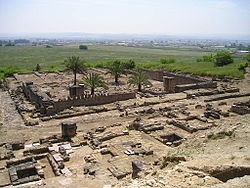Madīnat az-zahrāʾ
| Caliphate city of Madīnat az-Zahrā | |
|---|---|
|
UNESCO world heritage |
|

|
|
| Main mosque |
|
| National territory: |
|
| Type: | Culture |
| Criteria : | (iii) (iv) |
| Surface: | 111 ha |
| Buffer zone: | 2186 ha |
| Reference No .: | 1560 |
| UNESCO region : | Europe and North America |
| History of enrollment | |
| Enrollment: | 2018 ( session 42 ) |
Madīnat az-zahrāʾ or Medina Azahara مدينة الزهراء / madīnatu ʾz-zahrāʾ / 'the city of the Zahra', by Abd ar-Rahman III. (al-Nasir) from the dynasty of the Umayyad caliphs of Córdoba in 936 and originally dedicated to one of his concubines named az-Zahraʾ, is a former palace city in southern Spain. It was about eight kilometers west of Córdoba with a view of the valley and Córdoba. The complex has been preserved as a ruin with some prominent building remains.
The construction of the palace city began in 936 under the supervision of the master architect Maslama ibn Abdallah. In 945 the court of Córdoba moved to the city, which at that time already had the main mosque (Ǧāmiʿ) (941). The mint was moved here around 947/48. Nevertheless, the final completion took until the reign of Al-Hakam II. This explains the stylistic differences between the city and the extension of the Mosque of Cordoba , which was commissioned by the son and successor of Al-Nasir.
The palace complex is located on a foothill of the Sierra Morena , at the foot of the mountain Yebel al-Arus ( Eng . "Mountain of the newlyweds", Spanish Monte de la Desposada ), opposite the Guadalquivir valley. The complex is divided into terraces, the top one being that of the caliph , the one below that of the administrative officials (house of the vizier , life guard, salon Rico, administrative departments, gardens, etc.). Another level below is the actual city with houses, workshops and the main mosque, which was separated from the two palace areas by a wall.
If Islamic urban planning is otherwise more of a labyrinthine or even chaotic system, Medina Azahara, on the other hand, is laid out at right angles, on an area of around 1500 m × 750 m, with a well-planned fresh and sewage network. The facility is considered to be the largest urban settlement in the Mediterranean region that was planned and laid out in one go.
So far (as of 2015) around 10% of the area has been excavated, with the Salón Rico protruding. It was used to receive important envoys and has three naves separated by red and bluish marble arches, which are closed off at the head end by a transept. The lower half of the walls of the salon were decorated with marble plant motifs, followed by different motifs. The whole thing was completed by the typical Moorish wood carvings. The truncated columns consist of alternating blue and pink marble.
Despite the high quality and durable materials, Medina Azahara did not even last a century as it was conquered and destroyed as early as 1010 as a result of the civil war that brought the downfall of the Caliphate of Cordoba. Looting and clearing continued in the centuries that followed. The facility was used as a quarry for other structures and later buildings. In 2018, Medina Azahara was added to the World Heritage List.
literature
- Marianna Barrucand, Achim Bednorz: Moorish architecture in Andalusia. Taschen, Cologne 2007, ISBN 978-3-8228-3067-3 .
- Burchhard Brentjes: The Moors. Islam in North Africa and Spain. 2nd Edition. Koehler & Amelang, Leipzig 1992, ISBN 3-7338-0115-6 .
- Richard Ettinghausen , Oleg Grabar, Marilyn Jenkins-Madina: Islamic Art and Architecture 650-1250. Yale University Press 2001, pp. 89-91.
- Pierre Guichard: Al-Andalus. Eight centuries of Muslim civilization in Spain. Wasmuth, Tübingen 2005, ISBN 3-8030-4028-0 .
- Markus Hattstein, Peter Delius (Ed.): Islam. Art and architecture. Ullmann, Königswinter 2005, ISBN 978-3-8331-3533-0 .
- Arnold Hottinger : The Moors. Arabic culture in Spain . Reprint of the 3rd edition, Wilhelm Fink Verlag, Munich 2005, ISBN 3-7705-3075-6 .
- Antonio Muñoz Molina : City of the Caliphs. Historical forays through Cordoba. Rowohlt, Reinbek 1994, ISBN 978-3-499-13281-0 .
- Cuadernos de Madīnat al-Zahrāʾ. Junta de Andalucía, Consejería de Cultura, 1988-, ISSN 1139-9996 .
Individual evidence
Web links
- Information about Medina Azahara on the Official Website for Tourism in Spain (German)
- Cordoba 3D - Medina Azahara 3D
- Entry on the UNESCO World Heritage Center website ( English and French ).
Coordinates: 37 ° 53 ′ N , 4 ° 52 ′ W



